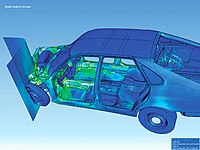
Photo from wikipedia
In the modelling of reinforced concrete (RC) buildings, the rigid diaphragm hypothesis to represent the in-plane behavior of floors was and still is very commonly adopted because of its simplicity… Click to show full abstract
In the modelling of reinforced concrete (RC) buildings, the rigid diaphragm hypothesis to represent the in-plane behavior of floors was and still is very commonly adopted because of its simplicity and computational cheapness. However, since excessive floor in-plane deformability can cause a very different redistribution of lateral forces on vertical resisting elements, it may be necessary to consider floor deformability. This paper investigates the classical yet intriguing question of modeling orthotropic RC floor systems endowed with lightening elements by means of a uniform orthotropic slab in order to describe accurately the building response under seismic loads. The simplified method, commonly adopted by engineers and based on the equivalence between the transverse stiffness of the RC elements of the real floor and those of the orthotropic slab, is presented. A case study in which this simplified method is used is also provided. Then, an advanced finite element (FE)-based method to determine the elastic properties of the equivalent homogenized orthotropic slab is proposed. The novel aspect of this method is that it takes into account the interaction of shell elements with frame elements in the 3D FE model of the building. Based on the results obtained from the application of this method to a case study, a discussion on the adequacy of the simplified method is also provided.
Journal Title: Applied Sciences
Year Published: 2023
Link to full text (if available)
Share on Social Media: Sign Up to like & get
recommendations!